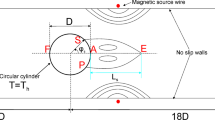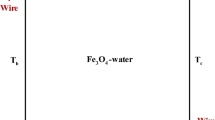Abstract
This paper presents the effect of a magnetic field on the ferrofluid flow pattern, heat transfer and entropy generation in a curved pipe. A non-uniform magnetic field is applied to ferrofluid (water + 2% vol. Fe3O4 nanoparticles) flow and under the constant heat flux boundary condition. Governing equations are solved by the finite volume method and based on the SIMPLE algorithm. The major objective of this work is to illustrate the effects of circumferential angle \(\left( {0^\circ \le \phi \le 180^\circ } \right)\) and strengths of a magnetic field \(\left( {0 \le {\text{Mn}} \le 3 \times 10^{6} } \right)\) on the hydro-thermal behavior and entropy production rate. It is found that circumferential angle of the magnetic source plays an important role in hydro-thermal performance of a curved pipe. At low magnetic numbers, the optimal circumferential location of the magnetic source is \(\phi_{\text{opt}} = 180^\circ\) which leads to the maximum heat transfer enhancement and hydro-thermal performance and the minimal entropy generation rate. For high magnetic numbers, the optimal operating condition occurs at \(\phi = 0^\circ\) and \(\phi = 60^\circ\) depending on the magnetic number. Second law analysis reveals that the major source of entropy generation comes from heat transfer irreversibility which reduces significantly by applying a magnetic field. In the range of studied parameters, the maximum heat transfer enhancement is about 29% which occurs at \(\phi = 0^\circ\) and \({\text{Mn}} = 3 \times 10^{6}\).



















Similar content being viewed by others
Abbreviations
- C:
-
Specific heat at constant pressure (Jkg−1K−1)
- d p :
-
Particle diameter (m)
- Ec:
-
Eckert number (−)
- H :
-
Magnetic field intensity (Am−1)
- I :
-
Electric current (A)
- K :
-
Thermal conductivity (Wm−1 K−1)
- k B :
-
Boltzmann constant (1.380648 × 10−23J K−1)
- Ms:
-
Saturation magnetization (Am−1)
- Mn:
-
Magnetic number (−)
- m p :
-
Magnetic moment of nanoparticles (Am2)
- Nu:
-
Nusselt number(−)
- P :
-
Pressure (Pa)
- Pr:
-
Prandtl number (−)
- q′′:
-
Heat flux (Wm−2)
- q*:
-
Non-dimensional heat flux (−)
- r :
-
Radial coordinate (m)
- R c :
-
Radius of curvature (m)
- Re:
-
Reynolds number (−)
- S f :
-
Volumetric entropy generation rate due to friction (Wm−3 K−1)
- S gen :
-
Total volumetric entropy generation rate (Wm−3 K−1)
- S T :
-
Volumetric entropy generation rate due to heat transfer (Wm−3 K−1)
- T :
-
Temperature (K)
- u, v, w :
-
Velocity components (ms−1)
- x, y, z :
-
Cartesian coordinates (m)
- α :
-
Particle volume fraction (−)
- μ :
-
Dynamic viscosity (Pa s−1)
- μ B :
-
Bohr magneton (9.274 × 10−24 Am2)
- μ o :
-
Vacuum permeability (Tm A−1)
- ξ :
-
Langevin parameter (−)
- ρ :
-
Density (kg m−3)
- ϕ v :
-
Viscous dissipation function (s−1)
- f:
-
Base fluid
- ff:
-
Ferrofluid
- in:
-
Inlet
- p:
-
Nanoparticle
- o:
-
Without magnetic field
References
Rosensweig RE (2013) Ferrohydrodynamics. Courier Corporation
Mehta JS, Kumar R, Kumar H, Garg H (2018) Convective heat transfer enhancement using ferrofluid: a review. J Therm Sci Eng Appl 10(2):020801
Bahiraei M, Hangi M (2015) Flow and heat transfer characteristics of magnetic nanofluids: a review. J Magn Magn Mater 374:125–138
Khairul MA, Doroodchi E, Azizian R, Moghtaderi B (2017) Advanced applications of tunable ferrofluids in energy systems and energy harvesters: a critical review. Energy Convers Manag 149:660–674
Yang RJ, Hou HH, Wang YN, Fu LM (2016) Micro-magnetofluidics in microfluidic systems: a review. Sensors Actuators B: Chem 224:1–15
Aursand E, Gjennestad MA, Lervåg KY, Lund H (2016) Potential of enhancing a natural convection loop with a thermomagnetically pumped ferrofluid. J Magn Magn Mater 417:148–159
Li Q, Lian W, Sun H, Xuan Y (2008) Investigation on operational characteristics of a miniature automatic cooling device. Int J Heat Mass Transf 51(21–22):5033–5039
Xuan Y, Lian W (2011) Electronic cooling using an automatic energy transport device based on thermomagnetic effect. Appl Therm Eng 31(8–9):1487–1494
Zimmermann K, Zeidis I, Böhm V, Greiser S, Popp J (2010) Ferrofluid-based flow manipulation and locomotion systems. J Intell Mater Syst Struct 21(15):1559–1562
Shokrollahi H (2013) Structure, synthetic methods, magnetic properties and biomedical applications of ferrofluids. Mater Sci Eng, C 33(5):2476–2487
Cardoso VF, Francesko A, Ribeiro C, Bañobre-López M, Martins P, Lanceros-Mendez S (2018) Advances in magnetic nanoparticles for biomedical applications. Adv Healthc Mater 7(5):1700845
Huang W, Wang X (2016) Ferrofluids lubrication: a status report. Lubr Sci 28(1):3–26
Urreta H, Aguirre G, Kuzhir P, de Lacalle LNL (2018) Seals based on magnetic fluids for high precision spindles of machine tools. Int J Precis Eng Manuf 19(4):495–503
Huang C, Yao J, Zhang T, Chen Y, Jiang H, Li D (2017) Damping applications of ferrofluids: a review. J Magn 22(1):109–121
Goharkhah M, Ashjaee M, Shahabadi M (2016) Experimental investigation on convective heat transfer and hydrodynamic characteristics of magnetite nanofluid under the influence of an alternating magnetic field. Int J Therm Sci 99:113–124
Sheikholeslami M, Rashidi MM, Ganji DD (2015) Numerical investigation of magnetic nanofluid forced convective heat transfer in existence of variable magnetic field using two phase model. J Mol Liq 212:117–126
Sheikholeslami M, Chamkha AJ (2016) Flow and convective heat transfer of a ferro-nanofluid in a double-sided lid-driven cavity with a wavy wall in the presence of a variable magnetic field. Numer Heat Transf Part A: Appl 69(10):1186–1200
Shakiba A, Vahedi K (2016) Numerical analysis of magnetic field effects on hydro-thermal behavior of a magnetic nanofluid in a double pipe heat exchanger. J Magn Magn Mater 402:131–142
Aminfar H, Mohammadpourfard M, Zonouzi SA (2013) Numerical study of the ferrofluid flow and heat transfer through a rectangular duct in the presence of a non-uniform transverse magnetic field. J Magn Magn Mater 327:31–42
Aminfar H, Mohammadpourfard M, Ahangar Zonouzi S (2014) Numerical investigation of the transient hydrothermal behavior of a ferrofluid flowing through a helical duct in the presence of nonuniform magnetic field. J Heat Transf. https://doi.org/10.1115/1.4026487
Aminfar H, Mohammadpourfard M, Kahnamouei YN (2014) Numerical study of magnetic field effects on the mixed convection of a magnetic nanofluid in a curved tube. Int J Mech Sci 78:81–90
Mousavi SM, Jamshidi N, Rabienataj-Darzi AA (2019) Numerical investigation of the magnetic field effect on the heat transfer and fluid flow of ferrofluid inside helical tube. J Therm Anal Calorim 137(5):1591–1601
Vafeas P, Bakalis P, Papadopoulos PK (2019) Effect of the magnetic field on the ferrofluid flow in a curved cylindrical annular duct. Phys Fluids 31(11):117105
Bahiraei M, Hosseinalipour SM, Hangi M (2014) Numerical study and optimization of hydrothermal characteristics of Mn–Zn ferrite nanofluid within annulus in the presence of magnetic field. J Supercond Novel Magn 27(2):527–534
Fadaei F, Shahrokhi M, Dehkordi AM, Abbasi Z (2017) Heat transfer enhancement of Fe3O4 ferrofluids in the presence of magnetic field. J Magn Magn Mater 429:314–323
Gerdroodbary MB, Sheikholeslami M, Mousavi SV, Anazadehsayed A, Moradi R (2018) The influence of non-uniform magnetic field on heat transfer intensification of ferrofluid inside a T-junction. Chem Eng Process 123:58–66
Hekmat MH, Ziarati KK (2019) Effects of nanoparticles volume fraction and magnetic field gradient on the mixed convection of a ferrofluid in the annulus between vertical concentric cylinders. Appl Therm Eng 152:844–857
Dizaji AS, Mohammadpourfard M, Aminfar H (2018) A numerical simulation of the water vapor bubble rising in ferrofluid by volume of fluid model in the presence of a magnetic field. J Magn Magn Mater 449:185–196
Sun XH, Massoudi M, Aubry N, Chen ZH, Wu WT (2019) Natural convection and anisotropic heat transfer in a ferro-nanofluid under magnetic field. Int J Heat Mass Transf 133:581–595
Khosravi A, Malekan M, Assad ME (2019) Numerical analysis of magnetic field effects on the heat transfer enhancement in ferrofluids for a parabolic trough solar collector. Renew Energy 134:54–63
Özdemir MR, Sadaghiani AK, Motezakker AR, Parapari SS, Park HS, Acar HY, Koşar A (2018) Experimental studies on ferrofluid pool boiling in the presence of external magnetic force. Appl Therm Eng 139:598–608
Shyam S, Mehta B, Mondal PK, Wongwises S (2019) Investigation into the thermo-hydrodynamics of ferrofluid flow under the influence of constant and alternating magnetic field by InfraRed thermography. Int J Heat Mass Transf 135:1233–1247
Nessab W, Kahalerras H, Fersadou B, Hammoudi D (2019) Numerical investigation of ferrofluid jet flow and convective heat transfer under the influence of magnetic sources. Appl Therm Eng 150:271–284
Tzirtzilakis EE, Xenos MA (2013) Biomagnetic fluid flow in a driven cavity. Meccanica 48(1):187–200
Yamaguchi H (2008) Engineering fluid mechanics, vol 85. Springer, Berlin
Khanafer K, Vafai K, Lightstone M (2003) Buoyancy-driven heat transfer enhancement in a two-dimensional enclosure utilizing nanofluids. Int J Heat Mass Transf 46(19):3639–3653
Brinkman HC (1952) The viscosity of concentrated suspensions and solutions. J Chem Phys 20(4):571
Hamilton RL, Crosser OK (1962) Thermal conductivity of heterogeneous two-component systems. Ind Eng Chem Fundam 1(3):187–191
Bejan A (1982) Entropy generation through heat and fluid flow. Wiley, London
Patankar S (1980) Numerical heat transfer and fluid flow. CRC Press, London
Yasuo M, Wataru N (1965) Study on forced convective heat transfer in curved pipes:(1st report, laminar region). Int J Heat Mass Transf 8(1):67–82
Asfer M, Mehta B, Kumar A, Khandekar S, Panigrahi PK (2016) Effect of magnetic field on laminar convective heat transfer characteristics of ferrofluid flowing through a circular stainless steel tube. Int J Heat Fluid Flow 59:74–86
Bianco V, Chiacchio F, Manca O, Nardini S (2009) Numerical investigation of nanofluids forced convection in circular tubes. Appl Therm Eng 29(17–18):3632–3642
Meyer JP, Adio SA, Sharifpur M, Nwosu PN (2016) The viscosity of nanofluids: a review of the theoretical, empirical, and numerical models. Heat Transf Eng 37(5):387–421
Akbari M, Galanis N, Behzadmehr A (2011) Comparative analysis of single and two-phase models for CFD studies of nanofluid heat transfer. Int J Therm Sci 50(8):1343–1354
Duangthongsuk W, Wongwises S (2008) Effect of thermophysical properties models on the predicting of the convective heat transfer coefficient for low concentration nanofluid. Int Commun Heat Mass Transf 35(10):1320–1326
Kakaç S, Pramuanjaroenkij A (2016) Single-phase and two-phase treatments of convective heat transfer enhancement with nanofluids: a state-of-the-art review. Int J Therm Sci 100:75–97
Buongiorno J (2006) Convective transport in nanofluids. J Heat Transf 128(3):240–250
Motlagh SY, Soltanipour H (2017) Natural convection of Al2O3-water nanofluid in an inclined cavity using Buongiorno’s two-phase model. Int J Therm Sci 111:310–320
Pourfattah F, Motamedian M, Sheikhzadeh G, Toghraie D, Akbari OA (2017) The numerical investigation of angle of attack of inclined rectangular rib on the turbulent heat transfer of Water-Al2O3 nanofluid in a tube. Int J Mech Sci 131:1106–1116
Bezaatpour M, Goharkhah M (2019) Effect of magnetic field on the hydrodynamic and heat transfer of magnetite ferrofluid flow in a porous fin heat sink. J Magn Magn Mater 476:506–515
Author information
Authors and Affiliations
Corresponding author
Additional information
Technical Editor: Daniel Onofre de Almeida Cruz, D.Sc
Publisher's Note
Springer Nature remains neutral with regard to jurisdictional claims in published maps and institutional affiliations.
Rights and permissions
About this article
Cite this article
Soltanipour, H., Gharegöz, A. & Oskooee, M.B. Numerical study of magnetic field effect on the ferrofluid forced convection and entropy generation in a curved pipe. J Braz. Soc. Mech. Sci. Eng. 42, 135 (2020). https://doi.org/10.1007/s40430-020-2218-5
Received:
Accepted:
Published:
DOI: https://doi.org/10.1007/s40430-020-2218-5




